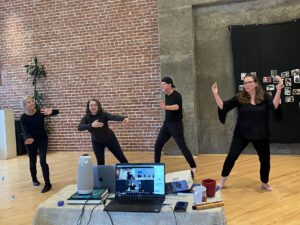 I spent the weekend in Oakland CA at InterPlayce, the home of the art-based improvisational system InterPlay, (an active creative approach to unlocking the wisdom of the body.) I’ve been a proponent, participant, practitioner, performer, teacher and altogether groupie fan of InterPlay since I was introduced to it in the early days of its development in 1992. Participating in this InterPlay Performance Workshop that focused on using the dancing, storytelling, singing, stillness forms to create a performance, in the moment and on the spot, took me back to the first time I ever witnessed this magical, transformational process.
I spent the weekend in Oakland CA at InterPlayce, the home of the art-based improvisational system InterPlay, (an active creative approach to unlocking the wisdom of the body.) I’ve been a proponent, participant, practitioner, performer, teacher and altogether groupie fan of InterPlay since I was introduced to it in the early days of its development in 1992. Participating in this InterPlay Performance Workshop that focused on using the dancing, storytelling, singing, stillness forms to create a performance, in the moment and on the spot, took me back to the first time I ever witnessed this magical, transformational process.
In 1993, according to the World Health Organization, approximately two million people were newly diagnosed with AIDS, raising the total since the start of the pandemic to more than 15 million. In the US, most of them were gay men. My son was one of them.
In addition to the fact that there were little-to-no effective treatments for the disease, Ken had been advised by the AIDS Outreach Center that, since he wanted to keep his job, he should tell no one, even his best friend about his diagnosis. They had lawyers that would help him get his job back, but the better path was for he and his family to keep his diagnosis a secret. This was the big picture of what our family was dealing with when we came together in the spring of 1994 from Texas, Oregon, and Southern CA in a hotel at the airport in San Francisco for a Aids, Medicine, and Miracles Conference.
There were 200 or so professional caregivers, physicians, nurses, social workers, alternative medicine practitioners, and patients. Dazed, and in and out of depression and denial, we were hoping for a miracle, and completely shocked to learn that, though the conference had been advertised for families, we were the only family members present.
There were helpful demonstrations and suggestions–acupuncture can alleviate the side effect symptoms created by western medicines; meditation practice offers relief for the anxiety inherent in facing a life-threatening future. But it was the lunch time presentation that stays with me to this day. Here we were, in a large gathering space, seated at tables, opening our sandwiches from their plastic wrappings as the lights came up on a performance space elevated slightly above us. The session was not to be a lecture or demonstration but a presentation by the Wing It Performance Ensemble, directed by InterPlay founder and improvisational artist Phil Porter. I had recently been introduced to InterPlay through its other founder, Cynthia Winton-Henry, a dancing minister, and I was amazed at our good fortune in being able to see the company perform.
The theme was AIDS and the group played with words we called out from the audience. They created dances, songs, and stories, on the spot and in the moment, around themes like ‘fear,’ ‘taboos,’ ‘health,’ ‘being gay’, ‘medicine,’ and of course, ‘miracles.’ As witnesses and audience members we were mesmerized as company members lifted the curtain of shame and silence to miraculously reveal details of the lives we were living. Later, when I learned more about the InterPlay system, I realized there was a name for what was transpiring. The artists were dancing, singing and storytelling on our behalf. They were doing one of the things the arts do best for mourners, and everyone else–affirming our experience and expressing for us what we need to have expressed in order to process our grief and gratitude for the experiences of our lives.

